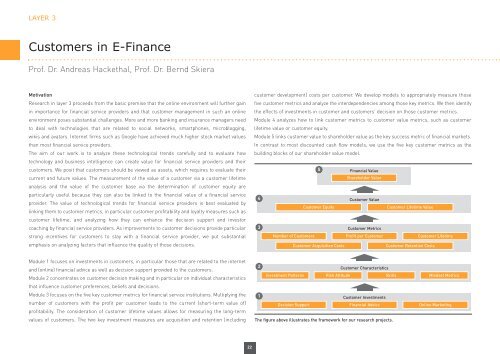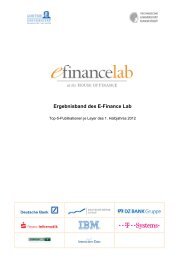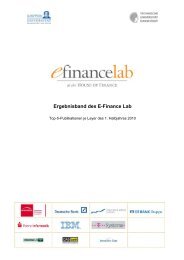The E-Finance Value Chain - E-Finance Lab Frankfurt am Main
The E-Finance Value Chain - E-Finance Lab Frankfurt am Main
The E-Finance Value Chain - E-Finance Lab Frankfurt am Main
Create successful ePaper yourself
Turn your PDF publications into a flip-book with our unique Google optimized e-Paper software.
LAYER 3<br />
Customers in E-<strong>Finance</strong><br />
Prof. Dr. Andreas Hackethal, Prof. Dr. Bernd Skiera<br />
Motivation<br />
Research in layer 3 proceeds from the basic premise that the online environment will further gain<br />
in importance for financial service providers and that customer management in such an online<br />
environment poses substantial challenges. More and more banking and insurance managers need<br />
to deal with technologies that are related to social networks, smartphones, microblogging,<br />
wikis and avatars. Internet firms such as Google have achieved much higher stock market values<br />
than most financial service providers.<br />
<strong>The</strong> aim of our work is to analyze these technological trends carefully and to evaluate how<br />
technology and business intelligence can create value for financial service providers and their<br />
customers. We posit that customers should be viewed as assets, which requires to evaluate their<br />
current and future values. <strong>The</strong> measurement of the value of a customer via a customer lifetime<br />
analysis and the value of the customer base via the determination of customer equity are<br />
particularly useful because they can also be linked to the financial value of a financial service<br />
provider. <strong>The</strong> value of technological trends for financial service providers is best evaluated by<br />
linking them to customer metrics, in particular customer profitability and loyalty measures such as<br />
customer lifetime, and analyzing how they can enhance the decision support and investor<br />
coaching by financial service providers. As improvements to customer decisions provide particular<br />
strong incentives for customers to stay with a financial service provider, we put substantial<br />
emphasis on analyzing factors that influence the quality of those decisions.<br />
Module 1 focuses on investments in customers, in particular those that are related to the internet<br />
and (online) financial advice as well as decision support provided to the customers.<br />
Module 2 concentrates on customer decision making and in particular on individual characteristics<br />
that influence customer preferences, beliefs and decisions.<br />
Module 3 focuses on the five key customer metrics for financial service institutions. Multiplying the<br />
number of customers with the profit per customer leads to the current (short-term value of)<br />
profitability. <strong>The</strong> consideration of customer lifetime values allows for measuring the long-term<br />
values of customers. <strong>The</strong> two key investment measures are acquisition and retention (including<br />
22<br />
customer development) costs per customer. We develop models to appropriately measure those<br />
five customer metrics and analyze the interdependencies <strong>am</strong>ong those key metrics. We then identify<br />
the effects of investments in customer and customers' decision on those customer metrics.<br />
Module 4 analyzes how to link customer metrics to customer value metrics, such as customer<br />
lifetime value or customer equity.<br />
Module 5 links customer value to shareholder value as the key success metric of financial markets.<br />
In contrast to most discounted cash flow models, we use the five key customer metrics as the<br />
building blocks of our shareholder value model.<br />
4<br />
3<br />
2<br />
1<br />
5<br />
Financial <strong>Value</strong><br />
Shareholder <strong>Value</strong><br />
Customer <strong>Value</strong><br />
Customer Equity Customer Lifetime <strong>Value</strong><br />
Number of Customers<br />
Customer Metrics<br />
Profit per Customer Customer Lifetime<br />
Customer Acquisition Costs Customer Retention Costs<br />
Customer Characteristics<br />
Investment Patterns Risk Attitude Skills Mindset Metrics<br />
Decision Support<br />
Customer Investments<br />
Financial Advice Online Marketing<br />
<strong>The</strong> figure above illustrates the fr<strong>am</strong>ework for our research projects.








